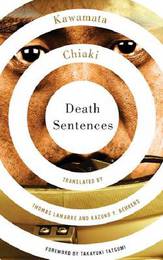
|
Death Sentences
Paperback / softback
Main Details
| Title |
Death Sentences
|
| Authors and Contributors |
By (author) Kawamata Chiaki
|
|
Translated by Thomas Lamarre
|
|
Translated by Kazuko Y. Behrens
|
| Physical Properties |
| Format:Paperback / softback | | Pages:224 | | Dimensions(mm): Height 203,Width 127 |
|
| Category/Genre | Crime and mystery
Horror and ghost stories
Science fiction |
|---|
| ISBN/Barcode |
9780816654550
|
| Classifications | Dewey:895.636 |
|---|
| Audience | |
|---|
|
Publishing Details |
| Publisher |
University of Minnesota Press
|
| Imprint |
University of Minnesota Press
|
| Publication Date |
24 February 2012 |
| Publication Country |
United States
|
Description
Japan, 1980s: A special police squad is tracking down one of the "afflicted" to recover the "stuff." Although the operation seems like a drug bust, the "stuff" is actually some kind of text. Death Sentences--a work of science fiction that shares its conceit with the major motion picture The Ring--tells the story of a mysterious surrealist poem, penned in the 1940s, which, through low-tech circulation across time, kills its readers, including Arshile Gorky and Antonin Artaud, before sparking a wave of suicides after its publication in 1980s Japan. Mixing elements of Japanese hard-boiled detective story, horror, and science fiction, the novel ranges across time and space, from the Left Bank of Paris to the planet Mars.
Author Biography
Kawamata Chiaki is well known in Japan as the author of science fiction novels. Thomas Lamarre is professor of East Asian studies and communication studies at McGill University. Kazuko Y. Behrens is assistant professor of development psychology at Texas Tech University. Takayuki Tatsumi is professor of English at Keio University.
Reviews"A hard-boiled, sharply surreal fable about the power of the written word." -William Gibson "Deeply rich in atmosphere and idea, Kawamata's first novel to be translated into English was a bestseller in its native Japan upon its publication in 1984. It deftly establishes the power of the central poems by showing their effects on the emotions, minds, bodies, and very consciousnesses of their readers; and proceeds to build living characters, central and minor, for their dangerous potential to impact." -Publishers Weekly
|